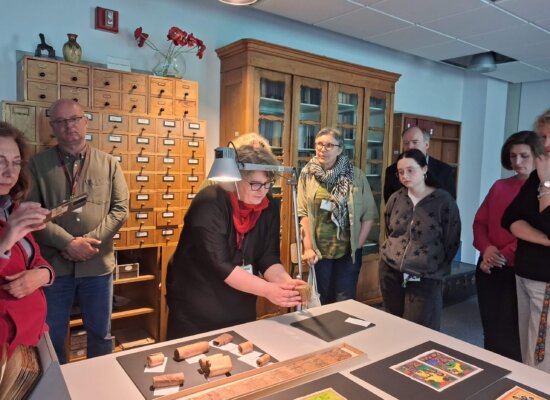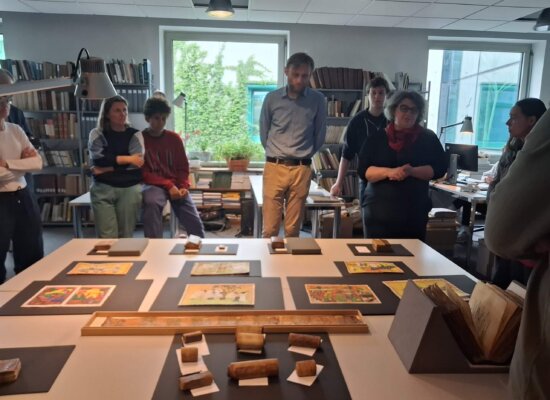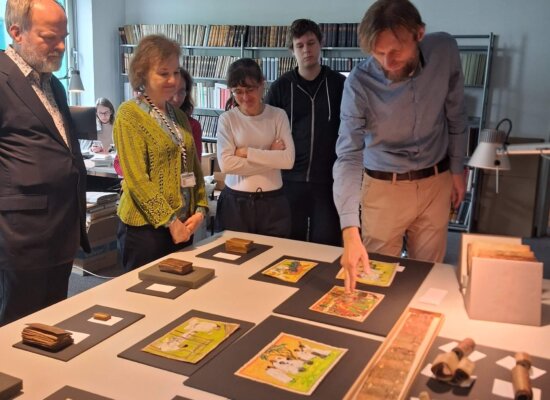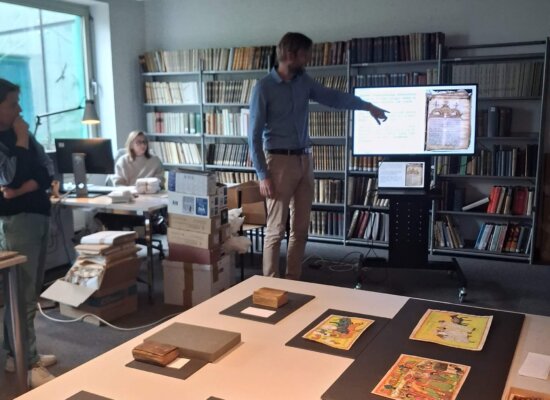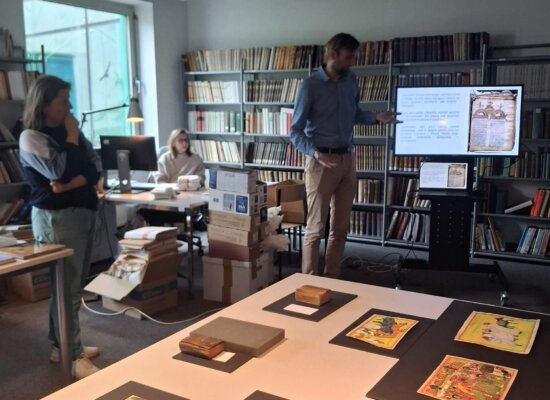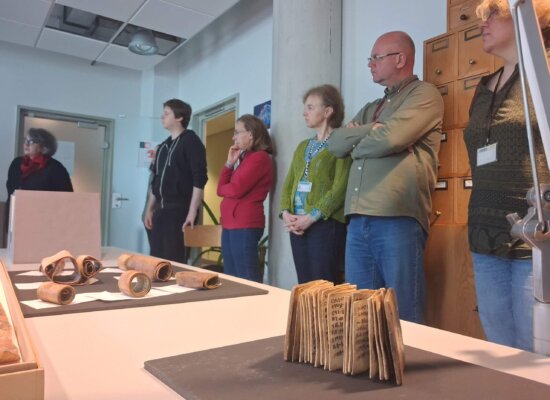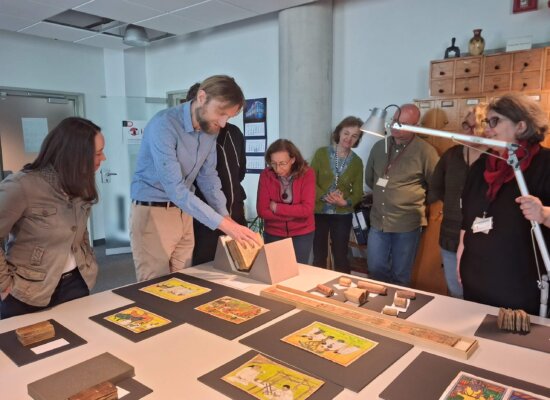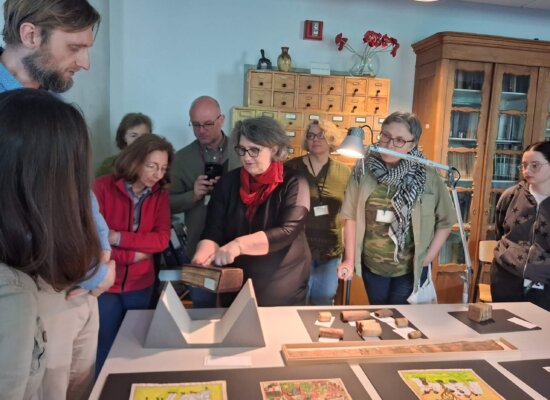Report on the Presentation of Ethiopian Manuscripts and Scrolls from the University of Warsaw Library collection

For several years now, at the turn of May and June, the Chair of African Languages and Cultures of the University of Warsaw has been organizing the Africa Days. One of the events of this year’s edition was a presentation of Ethiopian manuscripts and scrolls from the collections of the University of Warsaw Library, which was led by Dr. Marcin Krawczuk (KJiKA UW and the SIGLUM Team).
In the first part of the meeting, the speaker introduced the participants to the subject by presenting a presentation entitled “Christian Ethiopia and its manuscripts”. The participants learned the most important facts from the history of Ethiopian Orthodox Christianity: the arrival of the religion in the territories of present-day Ethiopia around 330, the Ge’ez language (classical Ethiopian) as the liturgical and literary language of Ethiopian Christianity and the types of texts written in this language (translations of the Bible, apocrypha, liturgical books and sermons of the Church Fathers as well as original works in the aforementioned language, i.e. lives of the saints, chronicles and religious poetry).
The next part of the presentation concerned the material aspects of the Ethiopian book: its forms (codex, scroll, accordion), binding, writing surface (in Ethiopian tradition it was mainly parchment), writing materials and general principles of preparing the quires as well as the layout of the page before writing it, etc. Two types of books were discussed in more detail: psalters (which in the tradition of the Ethiopian Church, apart from the Book of Psalms itself, also contain biblical canticles, the Song of Songs and the poem Praise of Mary).
The second type of manuscripts discussed were magical scrolls: their content, form, decorations and their use as amulets protecting against diseases and evil spells were characterized. Although in Ethiopian Christianity,magical scrolls are an element of personal and folk piety, not only are they not forbidden, but they are made by people performing auxiliary functions in the church, namely debteras (in the singular: debtera), who, in addition to preparing scrolls, also deal with herbalism, performing ritual hymns and dances, and exorcisms.
The small collection of Ethiopian manuscripts at the University of Warsaw Library was gathered and donated by Prof. Stefan Strelcyn (1918-1981) – an orientalist, a pioneer of research on Ethiopian languages in Poland. The professor was particularly interested in Ethiopian magic and herbal medicine, which is why a large part of the objects from his collection concern this subject. In addition to manuscripts in the Ge’ez language, the donated collection includes drawings with both religious and secular themes. Although they are not strictly related to the theme of the show, they have become a decorative element and an introduction to the realities of life in Ethiopia.
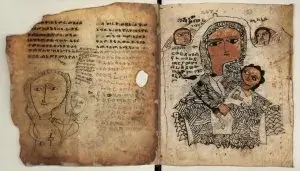 The most valuable object in the collection is the Psalter (inventory no. 3510) with standard content and somewhat crude decorations. Several magical scrolls (inventory no. 3647 – inventory 3654) represent the type of texts that Professor Strelcyn was most interested in. One of them, the oldest, from the 18th century (inventory no. 3649) is permanently unfolded and serves to present typical content and decorations; the others are kept in a traditional, rolled-up form. Two more manuscripts also contain magical texts: one in the form of an accordion (inventory no. 3646), the other in the form of a codex (inventory no. 3511).
The most valuable object in the collection is the Psalter (inventory no. 3510) with standard content and somewhat crude decorations. Several magical scrolls (inventory no. 3647 – inventory 3654) represent the type of texts that Professor Strelcyn was most interested in. One of them, the oldest, from the 18th century (inventory no. 3649) is permanently unfolded and serves to present typical content and decorations; the others are kept in a traditional, rolled-up form. Two more manuscripts also contain magical texts: one in the form of an accordion (inventory no. 3646), the other in the form of a codex (inventory no. 3511).
Four more codexes contain religious texts. Each of them is interesting in its own way: one is a miniature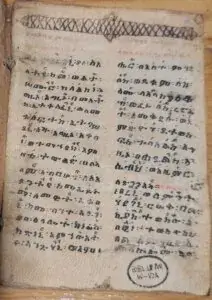 measuring 4.5 x 3 cm (inventory no. 3515), another – inventory no. 3512 contains musical notation; Inventory no. 3514 contains poetry, including an example of a poem popular in Ethiopia called mälkə. Works of this type are based on an interesting, although surprising from a European perspective, concept; namely, they contain praise for individual parts of the body of a chosen saint. The first stanza praises the highest parts of the body (hair, head), and the subsequent elements gradually lower parts. The last of the presented manuscripts, Inventory no. 3513, contains a collection of very diverse texts copied in different periods and probably by different people; it was probably a handy set of the most useful prayers, spells and divination texts used on a daily basis by – perhaps – some debtera.
measuring 4.5 x 3 cm (inventory no. 3515), another – inventory no. 3512 contains musical notation; Inventory no. 3514 contains poetry, including an example of a poem popular in Ethiopia called mälkə. Works of this type are based on an interesting, although surprising from a European perspective, concept; namely, they contain praise for individual parts of the body of a chosen saint. The first stanza praises the highest parts of the body (hair, head), and the subsequent elements gradually lower parts. The last of the presented manuscripts, Inventory no. 3513, contains a collection of very diverse texts copied in different periods and probably by different people; it was probably a handy set of the most useful prayers, spells and divination texts used on a daily basis by – perhaps – some debtera.
Almost 30 people took part in two presentations. The books in Ge’ez written in Ethiopian script provoked many comments and questions. One of the requests concerned the sound of the Ge’ez language, so Dr. Krawczuk read and translated a fragment of Psalm 1. For many participants, this was their first contact with this language. The Psalms are sung during the Ethiopian liturgy. Sample performances can be found, for example, on YouTube.
Some links of interest:
- Ethiopic Manuscript Production
- African Scribes: Manuscript Culture of Ethiopia
- Exploring Sensuls: An Indigenous Manuscript Tradition in Ethiopia
Images: Urszula Szwed-Strych, Agnieszka Fabiańska

